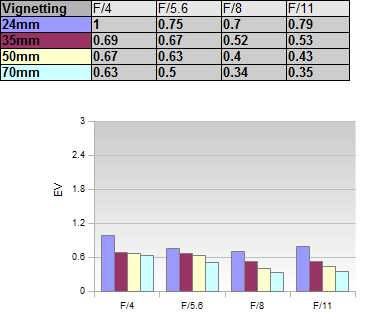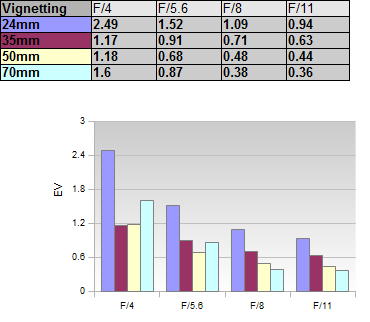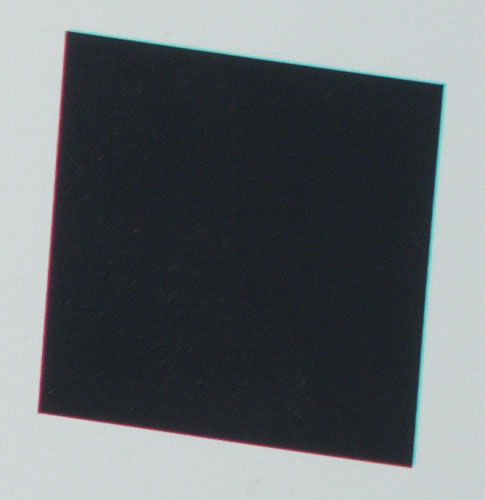|
Carl-Zeiss Vario-Tessar T* FE 24-70mm f/4 ZA OSS (Sony SEL2470Z) - Review / Test Report - Analysis |
|
Lens Reviews -
Sony Alpha (Full Format)
|
|
Page 2 of 3

Distortion
As a user you can select whether your images shall be auto-corrected or remain in true RAW mode. In auto-corrected mode, there is, unsurprisingly, nothing to worry about. The distortions stay at less than 0.5% which is negligible. However, the situation changes completely when looking at the original characteristic of the lens. It shows a hefty ~3.8% barrel distortion at 24mm and a 3% pincushion distortion towards the long end of the zoom range. This is hardly impressive for such a pricey lens.
If you move your mouse cursor over the image you can switch to the corresponding auto-corrected results (there may be a short delay).
Vignetting
The auto-corrected light falloff at max. aperture is very moderate for a lens on a full format camera. At f/4, we are seeing a max. light falloff of 1EV (f-stops) at 24mm and even less so at other settings. Stopping down reduces the vignetting further albeit not significantly.
 The situation changes when looking at the uncorrected data. At fully open aperture, the falloff is a hefty 2.5EV at 24mm. Stopping down to f/8 gives you ~1.1EV which is nothing to rave about either but it is acceptable for a full format lens. The issues eases at longer focal lengths where light falloff is mostly a moderate issue at f/4 only.
The situation changes when looking at the uncorrected data. At fully open aperture, the falloff is a hefty 2.5EV at 24mm. Stopping down to f/8 gives you ~1.1EV which is nothing to rave about either but it is acceptable for a full format lens. The issues eases at longer focal lengths where light falloff is mostly a moderate issue at f/4 only.

MTF (resolution)
The resolution characteristic is a mixed bag. At 24mm the center resolution is superb even at f/4. The border quality is generally good but the corners are fairly soft even at f/11. 35mm and 50mm are sweet spots with a good outer image field at fully open aperture and good to very good results at around f/8. The weakest spot of the lens is at 70mm with a moderate center quality and rather poor borders/corners. Stopping down to f/5.6 is advisable - also for an extra boost in contrast. The sweet spot is reached between f/8 and f/11.
The centering quality of the tested sample was good for a lens with an optical image stabilizer.
Please note that the MTF results are not directly comparable across the different systems!
Below is a simplified summary of the formal findings. The chart shows line widths per picture height (LW/PH) which can be taken as a measure for sharpness.
If you want to know more about the MTF50 figures you may check out the corresponding Imatest Explanations
Chromatic Aberrations (CAs)
Lateral CAs can be auto-corrected either by the camera or via Sony's RAW converter. This is a lossless operation so it's a good idea to take advantage of this. However, the Zeiss is also reasonably well corrected - at least when looking at the border zone where the average CA pixel width varies around the 1px mark. This is pretty good for a lens tested on a 36 megapixel camera.
 That being said, the situation is quite a bit worse in the corners. Below is a sample crop which illustrates that the issue increases significantly here (about 3px). Again, this is nothing to worry about with activated auto-correction.
That being said, the situation is quite a bit worse in the corners. Below is a sample crop which illustrates that the issue increases significantly here (about 3px). Again, this is nothing to worry about with activated auto-correction.

Bokeh
The Carl-Zeiss Vario-Tessar T* FE 24-70mm f/4 OSS ZA has a moderate max. aperture. However, on a full format camera you can still achieve a decent amount of out-of-focus blur in certain scenes. Unfortunately the bokeh (the quality of the blur) isn't all that impressive. Out-of-focus highlights show an outlining effect plus a rather nervous inner zone.
 The rendition in the critical focus transition zone is also quite harsh with distinctive halos at contrast transitions in the image background. The less interesting image foreground is somewhat better.
The rendition in the critical focus transition zone is also quite harsh with distinctive halos at contrast transitions in the image background. The less interesting image foreground is somewhat better.

|